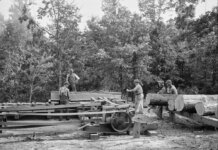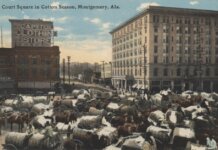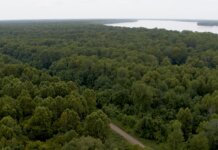
Conservation Resources, a New Hampshire-based investment firm, has launched a new program for its Alabama timberland. With 15,000 acres of Alabama’s trees in its domain, CR is implementing a program for its holdings that it terms “regenified” management.
Regenified is a practice and outcome-based land verification and certification program driving the growth of regenerative agriculture and the adoption of certified products. CR was the first institutional timberland manager to have properties certified by the program.
The firm is also perusing the 100 Million Acres Initiative. Founded by partners that include Conservation Resources, the program aims at transitioning 100 million acres — the approximate size of California — nationwide to regenerative management practices. In conjunction with the 10-year initiative, CR pledges to transition 100% of its managed lands to regenerative practices.
The company has evolved since its 2004 start up and continues to evolve.
“About six years ago, we started looking at agriculture in general,” recalls Paul Young, cofounder and CEO of CR. “One of the things we realized is the unintended consequences of agriculture processes.” A consensus was reached — there had to be a better way to grow crops, including those with bark.

Young notes, “A lot of our former methods of tree growth management affected soil health. Fertilizer run-off and water drainage effected the productivity of soil life.”
Young contacted Understanding Ag, a regenerative agricultural consulting company. “We started to look at ways we could improve the soil,” he says. It led to the new group/certification process named Regenified.
Originally, Regenified focused on agriculture and its effects on soil. “But I thought, wow, we can take these practices of regenerative improvement and apply it to the forest industry,” Young adds. “Trees grow in soil just like crops do. The healthier the soil the better the trees will be.”
Regenified involves several steps for certification.
“It’s a mindset,” says Young. “Timber management must no longer focus exclusively on growing trees as fast as we can. Instead, now we focus on how we can improve soil health.”
The program focuses on restoring the health of the entire ecosystem. It encourages biodiversity, soil health, water conservation and climate resilience.
Practices used in regenerative farming include minimizing soil disturbances, maintaining living roots, and keeping and building biodiversity.
Young adds, “Timber owners need to know how we can increase the life on the ground, underground and above it. How can we improve the soil’s biodiversity. If we are able to do that, trees by default will grow better.”
Nationally, CR has invested in 1,088,000 acres since its 2004 founding and currently manages 21 properties of timberland and farmland in 18 states, including Alabama.
“We have worked with CR since 2000,” says Russell Autrey, vice president of forestry services at Larson & McGowin. In addition to Mobile, the company has offices in Birmingham, Greenville and Jackson and operates on 900,000 acres in seven U.S. states and several countries.

“In Alabama, we work with CR in our forest management, including our Central Alabama’s Cottonseed Timberlands,” Autrey says. “CR has a unique perspective and innovative methods based on agriculture and adopted in the forestry programs.”
Speaking about CR’s local forestlands, Young notes, “We love Alabama. It is a great state to work. The markets are strong and its timber industry is well run. It is a unique state to do conservation practices in.”
On a similar ecological side note, he continues, “In working with Alabama, we fostered about 10% of habitat of the red hill salamander, which is an endangered species only located in Alabama and Georgia in the world.”
The company’s current acreage footprint in Alabama, all forestry, no farmland, includes Larson & McGowin’s Cottonseed property totaling 11,867 acres, plus 7,271 acres in Butler, Conecuh, Crenshaw and Monroe counties and 4,596 acres in Clay, Coosa and Talladega counties. Predominant products include chip-n-saw and softwood pulpwood. The year 2023 resulted in more than 40,000 tons being produced from the property.
Southbound in Barbour County has 4,192 acres and predominant products include softwood pulpwood and softwood sawtimber. 2023 resulted in more than 30,000 tons being produced from the property.
Young notes the difference between today’s timber practices and those of the past. He stresses nurturing the soil and everything else will fall in place. “We need to be mindful of disturbances of the soil,” he says. “If we can, let’s lessen fertilizing and try to reduce herbicides.”
“We are inoculating all of our seedlings when we plant them, with microscopic fungi,” Young adds. “If we can reestablish underground these tiny fungi networks, we are basically doubling or tripling the root system where nutrients can be treated far more efficiently. They can absorb phosphates and more water, which increases organic matter. “
Larson & McGowan’s Autrey agrees. “Their seedling inoculations to restore natural biome of our soils is one of many examples I can give you about CR’s unique methods,” he says.
From the first, CR says it has worked with the “vision that environmental and financial value are not only complementary, but mutually accretive.”
“It’s a cascading event,” Young says. “Improve the biodiversity underground first. Then it improves the trees.
“We ask ourselves, how can we make the forests we manage for our investors more resilient and more valuable? We believe these new approaches we are moving to will administer our timberland and the environment in the right way.”
Emmett Burnett is a Satsuma-based freelance contributor to Business Alabama.
This article appears in the March 2025 issue of Business Alabama.



